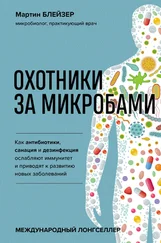«…выделяется белок, который мы назвали VacA»(см. с. 115): В статьях T. L. Cover et al., “Divergence of genetic sequences for the vacuolating cytotoxin among Helicobacter pylori strains,” Journal of Biological Chemistry 269 (1994): 10566–73 и T. L. Cover and M. J. Blaser, “Purifi cation and characterization of the vacuolating toxin from Helicobacter pylori ,” Journal of Biological Chemistry 267 (1992): 10570–75 описывается открытие белка, который мы назвали VacA, а затем мы назвали ген vacA . VacA был открыт как токсин, но теперь я считаю его сигнальной молекулой – с его помощью H. pylori говорит носителю, чего от него хочет. Один из эффектов VacA – подавление иммунного ответа T-лимфоцитов, что гарантирует его собственное выживание. (См. B. Gebert et al., “ Helicobacter pylori vacuolating cytotoxin inhibits T lymphocyte activation,” Science 301 [2003]: 1099–1102.) Если иммунный ответ подавить слишком сильно, то воспаление будет слабым, и, соответственно, H. pylori перестанет хватать питательных веществ. Так что приходится искать баланс. Много лет назад мы с Тимом предположили, что CagA – это «акселератор», а VacA – «тормоз». Идея до сих пор выглядит хорошей.
«А через два года»(см. с. 115): В 1989 году мы опубликовали статью в New England Journal of Medicine о связи H. pylori с гастритом (C. P. Dooley et al., “Prevalence of Helicobacter pylori infection and histologic gastritis in asymptomatic persons,” New England Journal of Medicine 321 [1989]: 1562–66), снова подтвердив полезность нашего анализа крови. Прочитав эту статью, доктор Номура написал мне. Мы общались в основном по почте, иногда – по телефону. Хотя мы плотно работали вместе над несколькими исследованиями, важными нам обоим, причем работали очень хорошо, лично мы встретились лишь через десять лет!
«…риск выше еще в два раза»(см. с. 116): Четыре статьи, изданные в 1991 году, показали заметную связь между наличием H. pylori и развитием рака желудка: J. Parsonnet et al., “ Helicobacter pylori infection and the risk of gastric carcinoma,” New England Journal of Medicine 325 (1991): 1127–31; A. Nomura et al., “ Helicobacter pylori infection and gastric carcinoma among Japanese Americans in Hawaii,” New England Journal of Medicine 325 (1991): 1132–36; D. Forman et al., “Association between infection with Helicobacter pylori and risk of gastric cancer: evidence from a prospective investigation,” British Medical Journal 302 (1991): 1302–5; and N. J. Talley et al., “Gastric adenocarcinoma and Helicobacter pylori infection,” Journal of the National Cancer Institute 83 (1991): 1734–39. Позже мы показали, что штамм с геном cagA практически удваивает риск развития рака желудка (M. J. Blaser et al., “Infection with Helicobacter pylori strains possessing cagA is associated with an increased risk of developing adenocarcinoma of the stomach,” Cancer Research 55 [1995]: 2111–15) и его предшественника, хронического атрофического гастрита (E. J. Kuipers et al., “ Helicobacter pylori and atrophic gastritis: importance of the cagA status,” Journal of the National Cancer Institute 87 [1995]: 1777–80).
«хорошая Helicobacter pylori – мертвая Helicobacter pylori »(см. с. 117): D. Y. Graham, “The only good Helicobacter pylori is a dead Helicobacter pylori ,” Lancet 350 (1997): 70–71.
«…древний организм»(см. с. 117): Доказательства древности H. pylori : D. Falush et al., “Traces of human migration in Helicobacter pylori populations,” Science 299 (2003): 1582–85; B. Linz et al., “An African origin for the intimate association between humans and Helicobacter pylori ,” Nature 445 (2007): 915–18; Y. Moodley et al., “The peopling of the Pacifi c from a bacterial perspective,” Science 323 (2009): 527–30; S. Breurec et al., “Evolutionary history of Helicobacter pylori sequences refl ect past human migrations in Southeast Asia,” PLOS ONE 6 (2011): e22058: 1–10; and Y. Moodley et al., “Age of the association between Helicobacter pylori and man,” PLOS Pathogens 8 (2012): e1002693: 1–16.
«…наличие его у матери»(см. с. 119): J. Raymond et al., “Genetic and transmission analysis of Helicobacter pylori strains within a family,” Emerging Infectious Diseases 10 (2004): 1816–21.
«…экология человеческого желудка заметно изменилась»(см. с. 121): M. J. Blaser, “ Helicobacter pylori eradication and its implications for the future,” Alimentary Pharmacology and Therapeutics 11, suppl. 1 (1997): 103–7; “Not all Helicobacter pylori strains are created equal: should all be eliminated?” 349 Lancet (1997): 1020–22; “Helicobacters are indigenous to the human stomach: duodenal ulceration is due to changes in gastric microecology in the modern era,” Gut 43 (1998): 721–27; “In a world of black and white, Helicobacter pylori is gray,” Annals of Internal Medicine 130 (1999): 695–97.
«…спокойно перейдут на другую сторону»(см. с. 122): M. J. Blaser and D. Kirschner, “The equilibria that allow bacterial persistence in human hosts,” Nature 449 (2007): 843–49.
«…15 миллионов – каждый день»(см. с. 127): G. M. Eisen et al., “The relationship between gastroesophageal refl ux and its complications with Barrett’s esophagus,” American Journal of Gastroenterology 92 (1997): 27–31; and H. B. El-Serag, “Time trends of gastroesophageal refl ux disease: a systematic review,” Clinical Gastroenterology and Hepatology 5 (2007): 17–26.
«…перерасти в аденокарциному, одну из форм рака»(см. с. 129): J. Lagergren et al., “Symptomatic gastroesophageal refl ux as a risk factor for esophageal adenocarcinoma,” New England Journal of Medicine 340 (1999): 825–31.
Читать дальше
Конец ознакомительного отрывка
Купить книгу







![Мартин Блейзер - Охотники за микробами. Как антибиотики, санация и дезинфекция ослабляют иммунитет и приводят к развитию новых заболеваний [litres]](/books/429953/martin-blejzer-ohotniki-za-mikrobami-kak-antibiot-thumb.webp)




